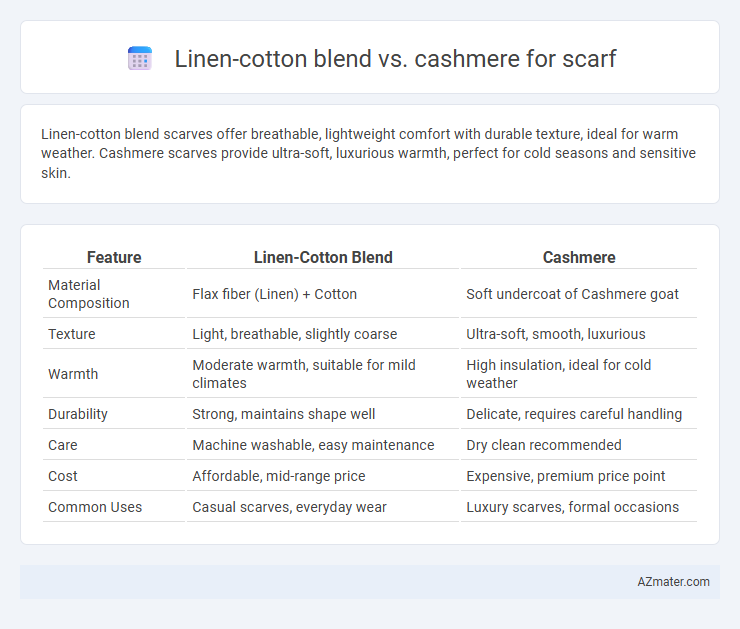Linen-cotton blend scarves offer breathable, lightweight comfort with durable texture, ideal for warm weather. Cashmere scarves provide ultra-soft, luxurious warmth, perfect for cold seasons and sensitive skin.
Table of Comparison
| Feature | Linen-Cotton Blend | Cashmere |
|---|---|---|
| Material Composition | Flax fiber (Linen) + Cotton | Soft undercoat of Cashmere goat |
| Texture | Light, breathable, slightly coarse | Ultra-soft, smooth, luxurious |
| Warmth | Moderate warmth, suitable for mild climates | High insulation, ideal for cold weather |
| Durability | Strong, maintains shape well | Delicate, requires careful handling |
| Care | Machine washable, easy maintenance | Dry clean recommended |
| Cost | Affordable, mid-range price | Expensive, premium price point |
| Common Uses | Casual scarves, everyday wear | Luxury scarves, formal occasions |
Introduction to Scarf Materials: Linen-Cotton Blend vs Cashmere
Linen-cotton blend scarves offer lightweight breathability and durability with natural moisture-wicking properties, making them ideal for warmer climates and everyday wear. Cashmere scarves provide unparalleled softness, exceptional warmth, and luxurious insulation suited for cold weather and sophisticated style. Choosing between linen-cotton blend and cashmere depends on climate, comfort preferences, and the desired balance between practicality and luxury.
Key Characteristics of Linen-Cotton Blend Scarves
Linen-cotton blend scarves combine the natural breathability and moisture-wicking properties of linen with the softness and durability of cotton, creating a lightweight and comfortable accessory ideal for mild to warm weather. These scarves offer excellent temperature regulation and wrinkle resistance, making them easy to care for and long-lasting. Their texture provides a casual yet refined look, suitable for both everyday wear and stylish layering.
Unique Features of Cashmere Scarves
Cashmere scarves are prized for their unparalleled softness, superior insulation, and lightweight warmth, setting them apart from linen-cotton blends that offer breathability and durability. The natural fine fibers of cashmere provide exceptional thermal regulation, making these scarves ideal for cold climates without adding bulk. Unlike the coarser texture of linen-cotton blends, cashmere delivers a luxurious feel and elegant drape that enhances both comfort and style.
Softness & Comfort: Which Feels Better?
Linen-cotton blend scarves offer a lightweight, breathable texture ideal for mild weather, with moderate softness that improves over time after washing. Cashmere scarves provide unparalleled softness and warmth due to their fine fibers, delivering a luxurious, cozy feel perfect for cold climates. For supreme comfort and softness, cashmere generally feels better, while linen-cotton blends excel in breathability and durability.
Warmth Comparison: Linen-Cotton Blend vs Cashmere
Cashmere scarves provide superior warmth due to their fine, insulating fibers that trap heat effectively, making them ideal for cold weather. Linen-cotton blend scarves offer moderate warmth with better breathability, suitable for mild to cool conditions. The thermal retention of cashmere surpasses that of linen-cotton blends, emphasizing cashmere's advantage in colder climates.
Breathability & Moisture Management
Linen-cotton blend scarves excel in breathability and moisture-wicking properties, offering superior airflow and quick drying, which keeps the skin comfortable in warm and humid conditions. Cashmere, while luxuriously soft and insulating, is less breathable and can retain moisture, making it more suitable for cooler, dry climates. For optimal comfort during extended wear, linen-cotton blends provide enhanced ventilation and moisture management compared to the naturally insulating but less breathable cashmere fiber.
Durability and Longevity of the Fabrics
Linen-cotton blends offer superior durability and longevity due to the combined strength of linen fibers with the softness of cotton, making them resistant to wear and frequent washing. Cashmere, while exceptionally soft and luxurious, tends to be more delicate and requires careful maintenance to prevent pilling and fiber breakdown. For long-term use and everyday durability, linen-cotton blend scarves provide a more resilient and easy-care option compared to the fragile nature of cashmere.
Style Versatility & Aesthetic Appeal
Linen-cotton blend scarves offer a lightweight texture and breathable comfort ideal for casual and transitional seasons, enhancing relaxed, effortless style versatility. In contrast, cashmere scarves provide luxurious softness and elegant drape, elevating formal and sophisticated ensembles with rich aesthetic appeal. The natural sheen of cashmere contrasts with the matte finish of linen-cotton, creating distinct visual characteristics suited to different fashion moods and occasions.
Care and Maintenance Requirements
Linen-cotton blend scarves require gentle washing with mild detergents and air drying to prevent shrinkage and maintain fabric integrity, while cashmere scarves demand more delicate care including hand washing with specialized cashmere shampoo or dry cleaning to preserve softness and avoid pilling. Linen-cotton blends are generally more durable and resistant to frequent washing, making maintenance easier for daily use. Cashmere's luxurious fibers are prone to damage from rough handling and improper washing, emphasizing the need for careful storage and minimal washing to prolong scarf lifespan.
Price Comparison and Value for Money
Linen-cotton blend scarves are significantly more affordable, typically ranging from $20 to $50, offering durability and breathability suitable for everyday wear. Cashmere scarves, priced between $100 and $500, provide exceptional softness, warmth, and luxurious feel but come with a higher investment. For value-conscious buyers, linen-cotton blends deliver practicality and cost efficiency, while cashmere scarves justify their premium price through unmatched comfort and long-lasting quality.

Infographic: Linen-cotton blend vs Cashmere for Scarf
 azmater.com
azmater.com